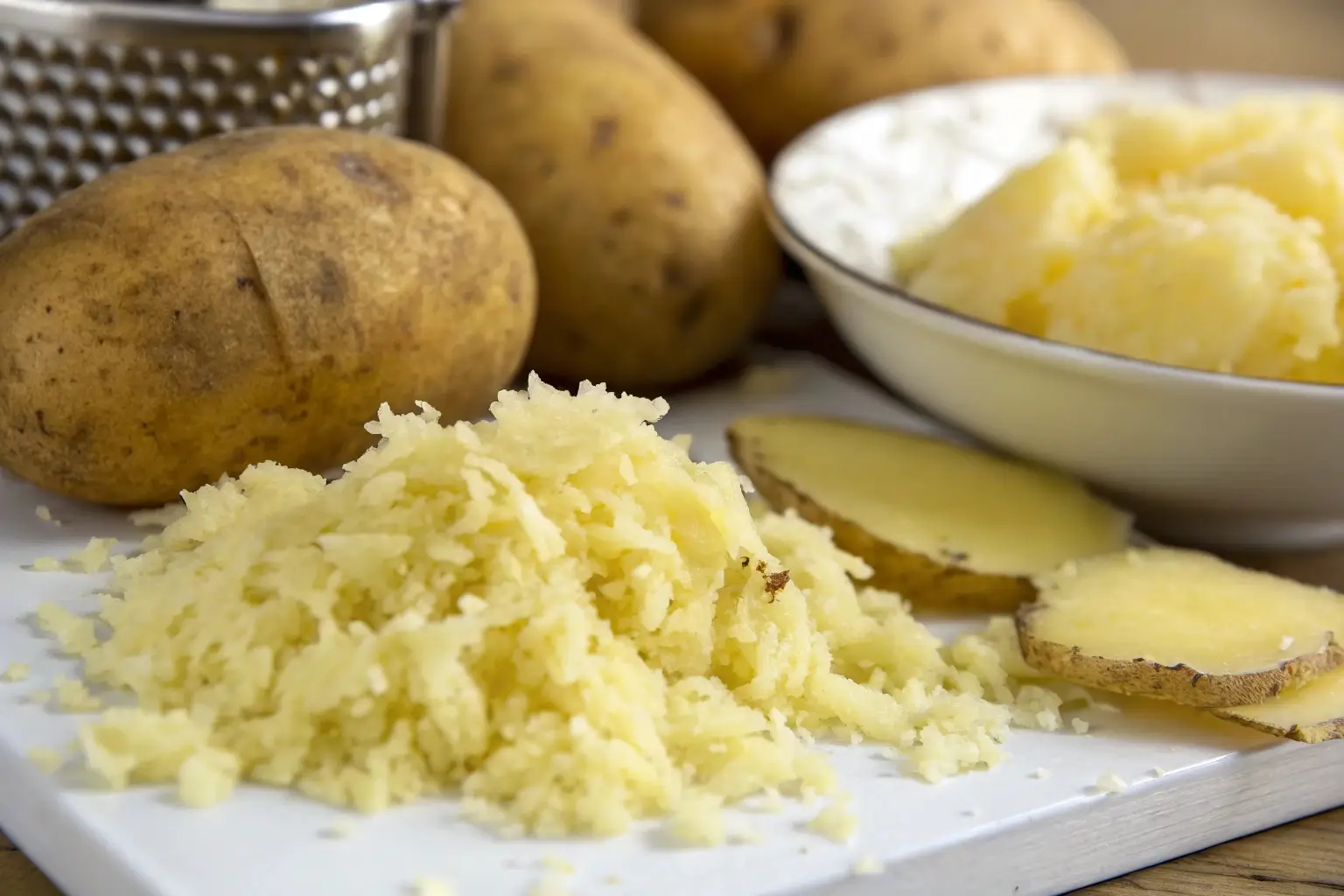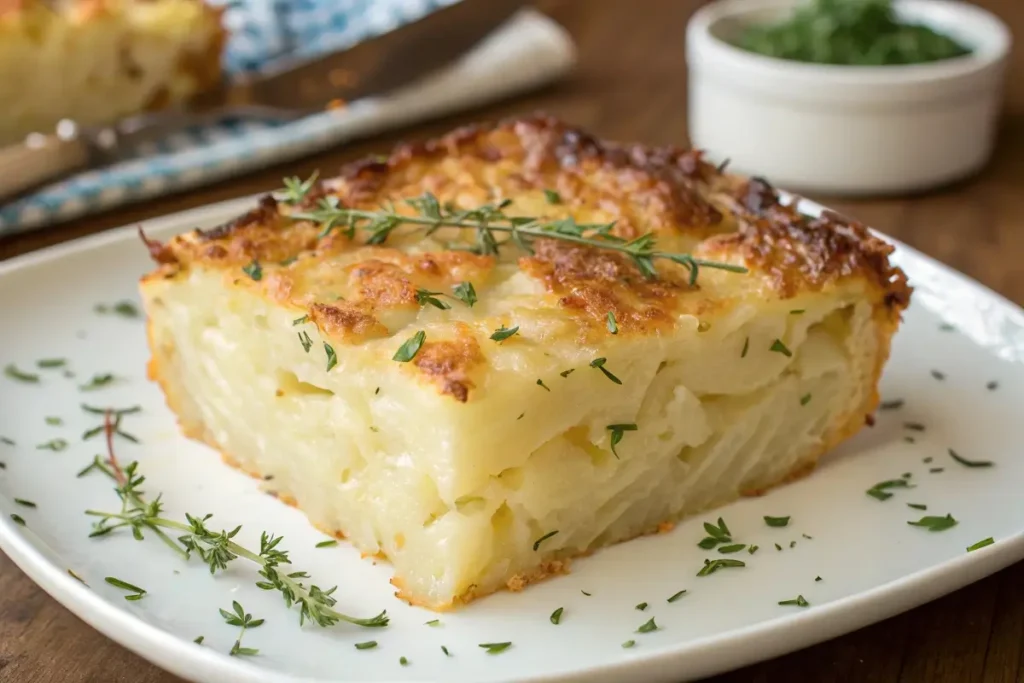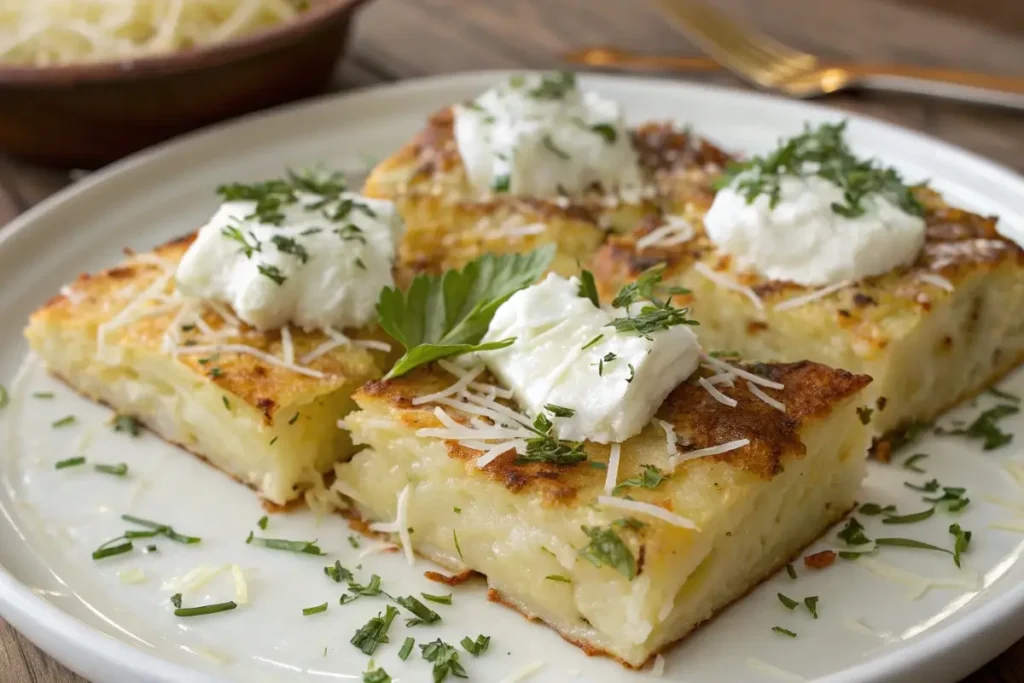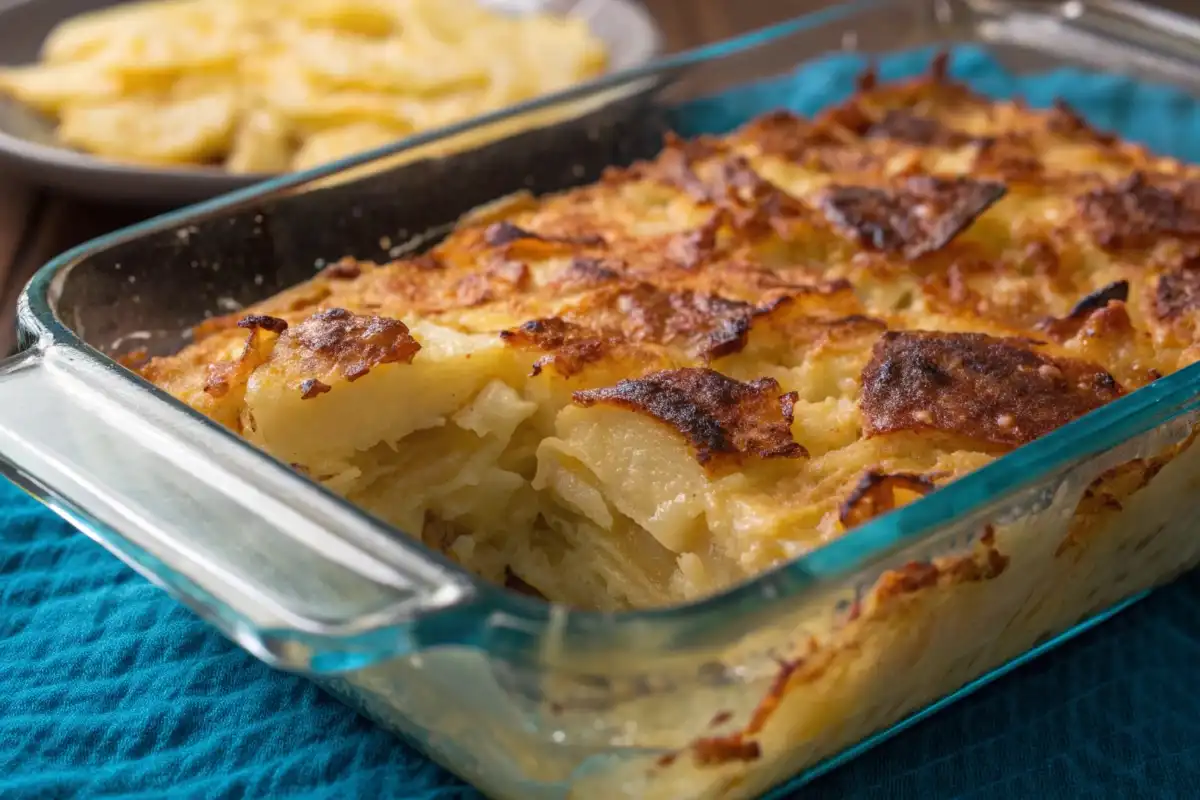Introduction
Potato kugel is a timeless dish that has graced tables across generations, particularly in Jewish households during holidays or family gatherings. If you’re asking yourself “What is potato kugel made of?” , you’re about to uncover the secrets behind this comforting casserole. Whether served as a savory side or a sweet dessert variation, potato kugel offers versatility and flavor that makes it a crowd favorite. In this comprehensive guide, we’ll delve into its history, ingredients, preparation methods, nutritional benefits, and even share some fun serving ideas. So, let’s dig in!
The Rich History of Potato Kugel
Potato kugel finds its roots in Eastern European Jewish cuisine, where kugels have been enjoyed for centuries. Originally, kugels were made with noodles, but when potatoes became widely available in Europe, they quickly replaced pasta as the base ingredient in many recipes. This shift gave rise to potato kugel, which remains one of the most beloved variations today.
Kugel, meaning “ball” in German, was traditionally cooked in round pans, though modern versions are often prepared in rectangular dishes. Over time, different communities adapted the recipe to suit their tastes, resulting in countless variations—from simple, rustic preparations to elaborate, cheese-laden creations. Today, potato kugel continues to evoke nostalgia and bring people together through its rich flavors and comforting texture.
Joke Time: Why did the potato go broke? Because it lost all its peels !
Understanding the Ingredients
To answer the question “What is potato kugel made of?” , let’s break down the essential components of this classic dish:
Key Ingredients Explained
- Potatoes
Potatoes form the foundation of kugel. They provide both structure and flavor, making them indispensable. For best results, use starchy varieties like Russets, which hold up well when grated and baked. - Eggs
Eggs act as a natural binder, holding the mixture together while adding moisture and richness. Depending on the desired texture, you can adjust the number of eggs used—more eggs create a fluffier kugel, while fewer eggs result in a denser consistency. - Onions
Onions add sweetness and aroma to the dish. Finely chopping or grating them ensures even distribution throughout the kugel. - Oil/Fat
Oil or fat is crucial for achieving those coveted crispy edges. Vegetable oil is commonly used, but alternatives like olive oil or schmaltz (rendered chicken fat) can enhance the flavor profile. - Binding Agents
Matzo meal or breadcrumbs help bind the ingredients together, preventing the kugel from falling apart. These agents also absorb excess moisture, ensuring a firmer texture. - Seasonings
Salt, pepper, garlic powder, paprika, and other spices elevate the taste of potato kugel. Experimenting with seasonings allows you to tailor the dish to your preferences.
Step-by-Step Potato Kugel Recipe
Ready to make your own potato kugel? Follow this detailed recipe to achieve restaurant-quality results at home.
Prep Time: 30 minutes
Cook Time: 45 minutes
Total Time: 75 minutes
Yield: Serves 6-8
Type of Dish: Side Dish
Cuisine: Jewish/Ashkenazi
Ingredients
| Ingredient | Quantity |
|---|---|
| Potatoes | 6 large |
| Eggs | 4 |
| Onions | 2 medium |
| Vegetable oil | 1/4 cup |
| Matzo meal | 1/2 cup |
| Salt | 1 tsp |
| Black pepper | 1/2 tsp |
Instructions
- Prepare Your Workspace
Begin by washing and peeling the potatoes. Use a box grater or food processor to finely grate them. Place the grated potatoes in a colander and press out as much liquid as possible using your hands or a clean kitchen towel. Removing excess moisture is key to achieving a crispy kugel. - Create the Batter
In a large mixing bowl, whisk together the eggs, grated onions, matzo meal, salt, and black pepper. Gradually incorporate the grated potatoes, stirring gently to combine. Be careful not to overmix, as this could break down the potato fibers and affect the final texture. - Heat the Oil
Preheat your oven to 375°F (190°C). Heat the vegetable oil in a skillet over medium heat. Once hot, fry a small portion of the potato mixture to test the seasoning. Adjust the salt and pepper if needed before proceeding. - Assemble the Kugel
Grease a 9×13-inch baking dish with additional oil to prevent sticking. Transfer the potato mixture to the dish, spreading it evenly with a spatula. Press down gently to compact the layers and ensure even cooking. - Bake Until Golden
Place the baking dish in the preheated oven and bake for approximately 45 minutes, or until the top is golden brown and the edges are crispy. To check doneness, insert a knife into the center of the kugel; it should come out clean. - Serve Warm
Allow the kugel to cool slightly before slicing into squares or wedges. Serve warm alongside roasted meats, brisket, or as a standalone side dish.

Nutritional Benefits of Potato Kugel
While potato kugel may seem indulgent, it offers several nutritional advantages when prepared mindfully. Here’s a breakdown of its health benefits:
- Low in Calories : A single serving contains around 250 calories, making it a satisfying yet relatively light option.
- Rich in Carbohydrates : Potatoes provide complex carbohydrates, offering sustained energy throughout the day.
- Good Source of Protein : Eggs contribute high-quality protein, supporting muscle repair and growth.
- Heart-Healthy Fats : Using healthy oils like olive oil instead of butter reduces saturated fat content.
Here’s a detailed nutrition table per serving:
| Nutrient | Amount per Serving |
|---|---|
| Calories | 250 kcal |
| Total Fat | 10 g |
| Saturated Fat | 1 g |
| Cholesterol | 120 mg |
| Sodium | 300 mg |
| Total Carbohydrates | 30 g |
| Dietary Fiber | 2 g |
| Sugars | 2 g |
| Protein | 6 g |
Expert Tips for Making Perfect Potato Kugel
Achieving a flawless potato kugel requires attention to detail. Here are some expert tips to refine your technique:
- Squeeze Out Excess Moisture : Removing water from the potatoes prevents sogginess and promotes crispiness.
- Use Fresh Ingredients : Fresh potatoes and onions yield better results than older produce. Avoid storing potatoes for too long before preparing the dish.
- Don’t Overmix : Combine the ingredients gently to avoid breaking down the potato fibers, which can lead to a dense kugel.
- Preheat the Oven : Ensure your oven is fully heated before placing the dish inside for even cooking.
- Add Texture Variations : Incorporate shredded cheese, chopped herbs, or diced bell peppers for added flavor and texture.
Creative Variations of Potato Kugel
One of the joys of cooking is experimenting with new flavors and techniques. Here are four exciting variations of potato kugel:
- Cheesy Potato Kugel : Stir in shredded cheddar, Parmesan, or mozzarella cheese for a decadent twist.
- Herbed Kugel : Mix fresh herbs like parsley, dill, or thyme for an aromatic finish.
- Spicy Kugel : Add red pepper flakes, jalapeños, or hot sauce for a fiery kick.
- Sweet Kugel : Combine applesauce, cinnamon, and sugar for a dessert-like treat perfect for Shabbat or holiday meals.

Serving Suggestions and Pairings
Potato kugel is incredibly versatile, making it an excellent companion to a wide variety of dishes. Whether you’re hosting a holiday dinner or preparing a casual family meal, here are some serving suggestions and pairing ideas to elevate your dining experience:
As a Side Dish
Potato kugel pairs beautifully with hearty main courses. Consider serving it alongside:
- Roast chicken or turkey for a classic Shabbat or holiday spread.
- Brisket or beef stew for a comforting winter feast.
- Grilled or roasted vegetables like carrots, zucchini, or asparagus for a lighter option.
For Breakfast or Brunch
Transform potato kugel into a breakfast dish by slicing it into smaller portions and topping each piece with a fried egg, avocado, or smoked salmon. It’s a savory and satisfying way to start the day.
As a Standalone Dish
For vegetarian or vegan meals, potato kugel can shine on its own. Serve it warm with a side salad or a dollop of sour cream (or dairy-free alternative) for added richness.
Dessert-Inspired Variations
If you opt for a sweet version of potato kugel, consider serving it with vanilla ice cream, whipped cream, or a drizzle of honey. These decadent touches transform the dish into a delightful dessert.

Frequently Asked Questions (FAQs)
Q1: Can I make potato kugel ahead of time?
Yes, you can prepare the batter and refrigerate it overnight. Simply bake it when ready to serve. Alternatively, bake the kugel in advance and reheat it just before serving.
Q2: Should I peel the potatoes?
Peeling is optional but recommended for a smoother texture. Leaving the skins on adds fiber and nutrients, so it depends on your preference.
Q3: How do I store leftover potato kugel?
Store leftovers in an airtight container in the refrigerator for up to 3 days. Reheat in the oven for best results.
Q4: Can I freeze potato kugel?
Absolutely! Freeze individual portions for up to 3 months. Thaw overnight in the fridge before reheating.
Conclusion
By now, you should have a clear understanding of what potato kugel is made of and how to create a mouthwatering version at home. From its humble beginnings in Eastern European kitchens to its current status as a cherished comfort food, potato kugel embodies tradition and innovation. With its simple ingredients and endless customization possibilities, this dish is sure to become a staple in your culinary repertoire.
So, gather your loved ones, roll up your sleeves, and start creating memories with this golden casserole. Happy cooking!
